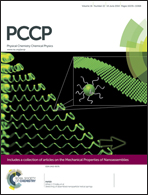Investigation of molecular partitioning between non polar oil droplets and aqueous solution using double potential step chronoamperometry
Abstract
Double potential step chronoamperometry (DPSC) is demonstrated as a technique for investigating partitioning between a solute in aqueous solution and non-polar oil droplet(s) immobilised at an electrode. Here a species in aqueous solution which does not partition into the oil phase is converted at the electrode surface into another species which either does not or does partition into the oil drop. The first case is investigated experimentally by considering generation of the ionic redox species, FcTMA2+ from FcTMA+, while the second case is exemplified by studies of Br2 generation from Br−. The case of molecular partitioning at the three phase interface has received little attention hitherto. To maintain oil droplet stability a boron-doped diamond electrode is employed functionalised with Pt nanoparticles to impart electrocatalytic activity on the electrode towards Br2 production. An arrangement is utilised where the droplet(s) sit(s) on (but does not cover) the electrode surface. We show both experimentally and through finite element simulation how the charge–time profile for the generation and collection of electroactive species can be used to obtain information on the extent of partitioning and how this is affected by factors such as the number and size of droplets. Finally, we highlight the suitability of this approach for investigating reactions which take place within the droplet.


 Please wait while we load your content...
Please wait while we load your content...